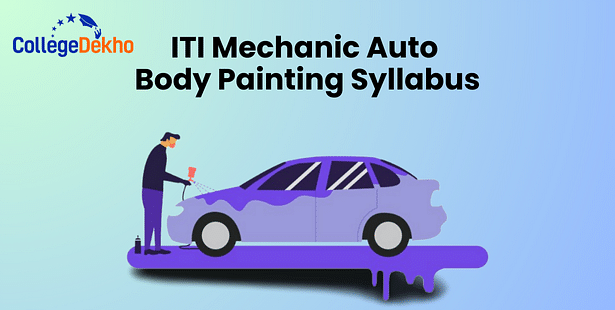
ITI Mechanic Auto Body Painting Syllabus: If you plan to apply for the ITI Mechanic Auto Body Painting program, it’s important to understand the syllabus. The syllabus lists the topics covered in the course, helping students plan their studies. Students should study the syllabus closely to do well in the course content. The ITI (Industrial Training Institute) Mechanic Auto Body Painting syllabus is divided into two semesters of six months. The course content is organised by semester, covering key components related to the trade.
Semester-wise ITI Mechanic Auto Body Painting Syllabus
The ITI Mechanic Auto Body Painting trade is of 1-year duration and divided into 2 semesters. Each semester covers different topics and techniques. Students can also find the official ITI Mechanic Auto Body Painting syllabus in the brochure - Official ITI Mechanic Auto Body Painting Syllabus PDF
ITI Mechanic Auto Body Painting Syllabus Semester I
In this semester, students will focus on safety, both in general and specific to the trade. They will learn to identify tools, equipment, and raw materials. Students will practice measuring and marking using various tools and will learn basic fastening and fitting operations. They will gain a foundational understanding of electricity and how to test and measure electrical parameters. Additionally, students will learn to identify different types of vehicles.
ITI Mechanic Auto Body Painting Syllabus Semester II
This semester allows students to practice using basic auto body hand and power tools. They will learn how to apply body filler materials and undercoats. Students will understand the causes and effects of corrosion on vehicles and how to protect against it. They will learn to use painting tools and equipment, including how to disassemble, clean, and put together paint guns. Students will master paint application techniques and learn to troubleshoot common paint problems. They will also use computer colour-matching systems and tint both solid and metallic colours. Additionally, they will demonstrate how to remove minor paint imperfections.
Detailed ITI Mechanic Auto Body Painting Syllabus
Admission & introduction to the trade: Introduction to the Course duration, course content, and study of the syllabus. General rule about the Institute, facilities available- Hostel, Recreation, Medical and Library working hours and timetable.
Occupational Safety & Health: The importance of safety and general precautions is to be observed in the shop. Basic first aid, safety signs - for Danger, Warning, caution & personal safety messages. Safe handling of Fuel Spillage, Fire extinguishers used for Different types of fire. safe disposal of toxic dust, safe handling and Periodic testing of lifting equipment, Authorization of Moving & road testing vehicles, Energy conservation-Definition, Energy Conservation Opportunities(ECOs)-Minor ECos and Medium ECOs, Major ECOs), Safety disposal of Used engine oil, Electrical safety tips. Hazard identification, spatter hazard etc and countermeasures to eliminate them & importance of usage of PPEs.
Hand Tools: Marking scheme, Marking material, Prussian blue. Cleaning tools- Scraper, wire brush, Emery paper, Description, care and use of Surface plates, steel rule, measuring tape, try square. Calipers-inside and outside. Dividers, surface gauges, scriber, punches-prick punch, centre punch, pin punch, hollow punch, number and letter punch. Chiselflat, cross-cut. Hammer- ball pein, lump, mallet. , Different types of - body hammers, pick hammers, Bumping hammers, finishing hammers, dolly blocks, body spoons, body picks, body pullers and pull rods, suction cups, scratch awls, Screw drivers-blade screwdrivers, Phillips screwdrivers, Ratchet screwdrivers. Allen key, bench vice & C-clamps, Spanners- ring spanner, open end spanner & the combination spanner, universal adjustable open end spanner. Sockets & Accessories, Pliers - Combination pliers, multi-grip, long nose, flat-nose, Nippers or pincer pliers, Metal cutting shears- Tin snips, sheet metal cutting pliers, (Aviation snips), panel cutters, trim and upholstery tools, Door handle tool ( clip pullers), Metal files, reveal file, surform file, sanding.
Systems of measurement: Description, care & use of Micrometers- Outside and depth micrometre, Micrometer adjustments, Vernier callipers, Telescope gauges, Dial bore gauges, Dial indicators, straightedge, feeler gauge, thread pitch gauge, vacuum gauge, tire pressure gauge.
Fasteners- Study of different types of screws, nuts, studs & bolts, locking devices, Such as lock nuts, cotter, split pins, keys, circlips, lock rings, lock washers and locating where they are used. Washers & chemical compounds can be used to help secure these fasteners. Selection of materials for gaskets and packing, Description of Riveting tools
Cutting tools: Study of different types of cutting tools like Hacksaw, File- Definition, parts of a file, specification, Grade, shape, different type of cut and uses.,chisel, OFF-hand grinding with sander, bench and pedestal grinders, and safety precautions while Grinding.
Limits, Fits & Tolerances: Definition of limits, fits &tolerances with examples used in auto components.
Taps and Dies: Hand Taps and wrenches, Calculation of Tap drill sizes for metric and inch taps. Different types of Die and Die stock. Screw extractors.
Hand Reamers - Different Types of hand reamers, Lapping, Lapping abrasives, and types of Laps. Function of Gaskets, Selection of materials for gaskets and packing, oil seals.
Basic electricity, Electricity principles, Ground connections, Ohm's law, Voltage, Current, Resistance, Power, and Energy. Voltmeter, ammeter, Ohmmeter Multimeter, Conductors & insulators, Wires, Shielding, Length vs. resistance, Resistor ratings.
Introduction to Engine: Description of internal & external combustion engines, Classification of IC engines, Principle & working of 2&4-stroke diesel engine (Compression ignition Engine (C.I)), Principle of Spark Ignition Engine(SI), differentiation between 2-stroke and 4 stroke, C.I engine and S.I. engine, Direct injection and Indirect injection, Technical terms used in the engine, Engine specification, Body shop & paint shop safety procedures.
Vehicle construction Technology: Definition of body shop, classification of body shop, Independent body shop, dealership body shop, speciality body shop. Description of vehicle Body and Chassis.
Compressor Air system: Basic requirement for compressed air systems, Type of CompressorDescription and construction of Diaphragm compressor, piton type compressor-single stage and two-stage, rotary screw air compressor, Performance of air compressor- Description of Horsepower, delivery volume, displacement, Free air delivery, compressor volumetric efficiency, tank size, Air and Fluid Control Equipment - Intake air filter, Distribution system, regulator, lubricator, different type air purification method, Compressor Accessories -Hose type, hose size, maintenance of hose, connectors, adapters and couplings, Air System Maintenance. Study the typical piping arrangement found in a body/paint shop, colour coding of airline, water line and fuel line.
Refinishing Materials: Primer-sealer, top coats, paint material types-Lacquer, enamel, water base, Content of paint-pain pigments, paint binders, paint solvents, Paint additives, Definition of Drying, curing, flash, retarder, accelerator, catalyst, adhesion promoter, blending solvent, Toners, Primers & sealers- self-etching primer, UV primer.
Using Body Fillers: Description of Body Fillers (Plastic filler), Body filler ingredients, Body filler hardeners, Putties, lightweight fillers, premium fillers, spot putties, polyester glazing putty, applying body filler, preparation surface for filler, Ingredient, characteristics and application of body filler & putties, Mixing filler, kneading the hardener, mixing filler and hardener, Spreading body filler, Grating and Sanding Body Filler-grating the filler, coarse, sandy filler, blow off sanding dust, checking filler repair, applying second filler coat, feathered giving body filler, applying filler to body lines, applying filler to panel joint, applying filler to body lines, applying lead filler, priming filler area, applying glazing putty, using a guide coat and Rust repair procedures.
Corrosion Protection: What Is Corrosion, Causes for Loss of Factory Protection, Anticorrosion Materials, Basic Surface Preparation, Corrosion Treatment Areas, Corrosion-Protection Primers, Exposed Joints, Exposed Interior Surfaces.
Estimating Repair: Costs Description of estimate, Direct repair programs, Estimate time factor, work orders, Using Estimate Guides, Part prices, Labor costs, Job overlap, and Included operation.
Refinishing Equipment Technology: Painting environment variable, Steps to keep dirt from finish during body repairs, Description of spray gun and its parts, basic stages of Atomization, HighVolume, Low-Pressure (HVLP) Spray Gun, Type of air spray gunGravity feed, Suction (siphon) feed, Pressure feed, Pressure-assist feed (gravity or suction cup spray guns) and their paint feed method, advantage and disadvantages.
Vehicle surface preparation and masking: Importance of surface preparation, Evaluate Surface Condition, Checking Paint Thickness, Pain Removal method- Chemical stripping, Media blasting procedure for operating a blaster, type of grit and numbering system. Sanding or grinding, Importance of Preparing Bare Metal-using metal conditioners, preparing hard chrome Surfaces, preparing metal Replacement parts, using self-etch primer, apply seam sealer Prime coat Selection, applying prime coats applying spot putty, or glazing putty. final sanding, using the right grit, Masking, surface sanding methods, power sanding, hand sanding, dry sanding, wet sanding, comparison between wet and dry sanding, surface scuffing, Surface Cleaning. Masking, basic ways to mask the parts of a vehicle, liquid masking material, liquid masking system, Procedure, plastic sheet masking. masking paper and tape, masking aids-wheel masks, masking panel gaps, masking openings.
Refinishing Procedures: Functions of paint, OEM paint finishes procedures, differences between OEM and refinish painting types of paint for topcoat refinishing, properties of paint used for refinishing. Topcoats, Prime coats, Preparing Refinish Materials, Pre-painting Preparations, Applying Prime coats, Refinishing Plastic Parts, Flash Times, Basic Spray Coats, Methods of Refinishing, Basecoat/Clearcoat Repairs, Applying Single Stage Paints, Panel Repairs, Overall Refinishing, Removal of Masking Materials.
Colour matching and Customized painting: Introduction, Color Theory, Lighting-colour evaluations using sunlight & colour corrected light bulb, dimensions of colourValue—lightness or darkness, Hue—colour, cast, or tint, Chroma saturation, richness, intensity, or muddiness, standard colour chips, variance colour chips.
Final detailing- Detail sanding procedure, Repairing paint runs, repairing chipped paint, panel detail sanding procedure, Paint compounding- purpose, rubbing compound, machine compounding, using buffers and polishers, avoiding paint burn-through, machine buffing procedures, hand and machine Glazing and polishing procedure, Final cleaning, steps for caring for a new finish.
ITI Mechanic Auto Body Painting Eligibility Criteria
Students interested in pursuing a diploma in ITI Mechanic Auto Body Painting course must have at least a class 10th qualification. ITI's Mechanic Auto Body Painting trade eligibility criteria are listed below:
- Passed 10th Class (recognised board and institute)
- students must be able to speak both English and Hindi fluently.
Related Reads:
This article provided important information about jobs related to Mechanic Auto Body Painting. To excel in the ITI Mechanic Auto Body Painting, it's essential to understand the syllabus. Create a study plan to cover all topics and ensure you practice and revise regularly to master the concepts.
If you have any queries, write to our experts on the CollegeDekho QnA Zone . For personalised assistance with admission to your chosen ITI college, fill out our Common Application Form (CAF) or call our helpline number 1800-572-9877.
Are you feeling lost and unsure about what career path to take after completing 12th standard?
Say goodbye to confusion and hello to a bright future!

FAQs
The trade code for ITI Mechanic Auto Body Painting is - 507. The Mechanic Auto Body Painting course is a part of the CTS program and is available at ITIs across the country.
Students interested in pursuing a diploma in ITI Mechanic Auto Body Painting course must have at least a class 10th qualification and must be able to speak both English and Hindi fluently.
The ITI Mechanic Auto Body Painting trade is of 1 year duration and divided into 2 semesters. Each semester covers different topics such as Occupational Safety and health, Cutting Tools, Drilling Machines, Vehicle construction Technology, Systems of measurement, Vehicle surface preparation and masking, Hand Tools, and Systems of Measurement, etc.
The course ‘Mechanic Auto Body Painting’ is of 1 year duration. It mainly consists of the Domain area and Core area. CTS courses are delivered nationwide through a network of ITIs.
The ITI Mechanic Auto Body Painting course is a one-year program that teaches students how to paint and repair the body of a car. After completing the program, students receive a National Trade Certificate (NTC) from DGT, which is recognised worldwide.
Was this article helpful?


















Similar Articles
ITI Admission 2025: State-wise Dates, Online Form, Fees, Merit List, Courses and Fees
West Bengal (WBSCVT) ITI Admission 2025: Registration, Merit List, Choice Filling, Seat Allotment, Fees, Trades
List of Top ITI Colleges in Bihar 2025: Private & Government
Bihar ITI Admission 2025: Dates, Eligibility, Application Form, Admission Process, Counselling
ITI Application Form 2025: Dates, Fee, Registration Process, Official Websites
List of Jobs Available After ITI Computer Operator and Programming Assistant Trade: Job Roles, Salary, ROI